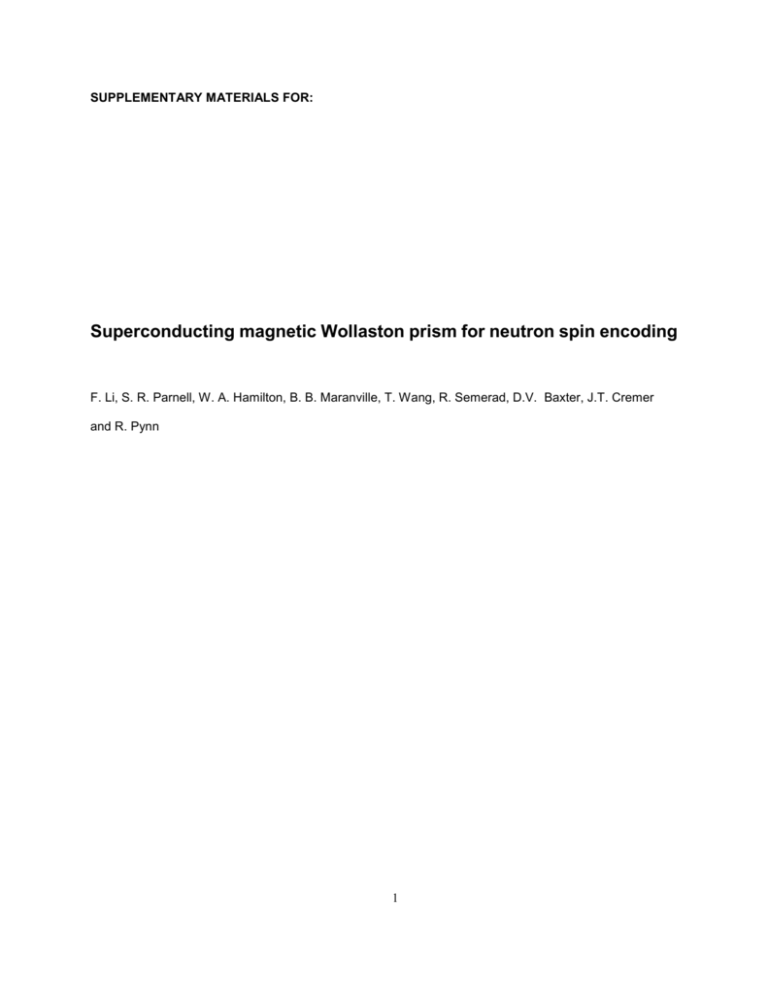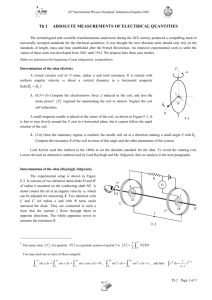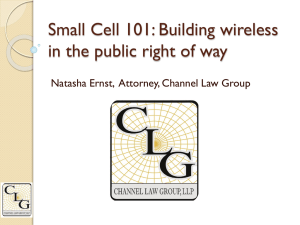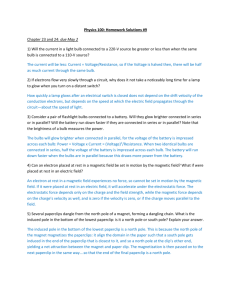S3 Calculation of Wollaston prism
advertisement

SUPPLEMENTARY MATERIALS FOR: Superconducting magnetic Wollaston prism for neutron spin encoding F. Li, S. R. Parnell, W. A. Hamilton, B. B. Maranville, T. Wang, R. Semerad, D.V. Baxter, J.T. Cremer and R. Pynn 1 S1 Model selection Figure 1. Models calculated with the magnetic field profile |B| at the mid-plane. Gray with black stripes: HTS film; purple: Mu metal yoke; dark red: soft ion pole pieces; brown: coils wound on pole pieces Model a): Hollow triangular coil with HTS film at hypotenuse only Model b): Triangular coil filled with pole pieces, HTS film at hypotenuse only Model c): Triangular coil filled with pole pieces, HTS films on the side and hypotenuse Model d): Triangular coil filled with pole pieces, HTS films on all sides Figure 2. Field intensity |B| of various models along z direction at the center of the triangular-cross section of various models. (a) Comparison between models with or without pole pieces. (b) Comparison among models with various configurations of HTS films. 2 As shown in Figure 1, possible configurations of the Wollaston prism were calculated using MagNet©1. In all models, the inclination angle of the triangular coils is kept at 45°. The resulting dependence of the magnetic field on z and field integral expansion (see eqn (2) of main paper) are summarized in Figure 2 and Figure 3 respectively. Figure 1 shows that the most uniform field profile on the z=0 plane is obtained when each triangular field region is bounded on all sides by a HTS film. From Figure 2, we see that a design with soft iron pole pieces, with HTS films on all three sides of each triangular region, generates the largest field with the best uniformity. As confirmed by the field integral expansion in Figure 3, this model gives the largest linear term a and the lowest aberration term d and thus is the best configuration. Figure 3. A comparision of the terms a and d for various configurations. Blue and red bars are for term a and d respectively and their values are also indicated. S2 Optimization of neutron optics In order to optimize the model, the dependence of term a and d on various parameters have been studied for the model with pole piece and all sides enclosed by HTS film. Parameters that were varied include the coil height, coil size, coil position, gap between pole pieces and gaps between coil and HTS film. 3 A. Change the height of coil Figure 4. The variation of term a and d as a function of coil height. The gap between upper and lower coils is fixed to be 40mm. The current density in the coils was 4 A/mm. Black hollow points with left axis are for term a and blue solid points and the right axis are for term d. The height of the coils is studied and shown in Figure 4. Since the term a and d both scale linearly with the height of the coils, the ratio of these terms is constant and there is no particular optimum height for the coils. B. Variation of the size and arrangement of coils Since each triangular-cross section coil has 3 round bending corners, there are at least two possible configurations for these coils, as shown in Figure 5 (a) and (b). The variations of the term a and d for both configurations are shown in Figure 5 (c). It is clear that increasing the width of the coil decreases the d term dramatically while the linear term a remains constant. Figure 5 also shows that the arrangement of the two triangles is important, with Figure 5 (b) describing the optimum choice. 4 (a) (b) (c) Figure 5. (a) and (b): top view of two possible arrangements of the triangular coils. (c): The variation of term a and d term when changing the width of the coil. Solid points are for model (a) while open points are for model (b). Black points are using the left axis and blue points are using the right axis. C. Variation of the gap between the pole pieces To calculate the maximum beam size, the gap between upper and lower coils was studied. As shown in Figure 6, when increasing the gap, the term a will decrease while term d will increase, which means the gap should be kept as small as the maximum beam size needed. Figure 6. The variation of term a and d as a function of the gap between upper and lower coils. Black hollow points with left axis are for term a and blue solid points and the right axis are for term d 5 Also a series of calculations have been carried out to determine the effects on field integral homogeneity of gaps between HTS films in the various designs. This was done because it is clearly easier to manufacture designs in which the tolerance on film positions is relaxed. The general finding from these calculations was that gaps between films need to be avoided where possible. D. Design of pole pieces (a) (b) Figure 7. a) The hollow pole piece calculated for the simulation, b) the field |B| mapping at y=0 plane for the model with hollow pole piece. In all the calculations described above, solid triangular-cross section soft iron pole pieces were used inside the coils. However thist increases the thermal mass at low temperature and increases the cool-down time. Thus a model with hollow pole pieces (Figure 7 (a)) has been calculated and shown not to affect either the term a or d in the expansion of the field integral compared with the model with solid pole pieces. Since the edge of pole piece are very close to the HTS films, a key parameter determining how much current we can apply is the quenching of the HTS film due to the component of the magnetic field perpendicular to the HTS films. The maximum value of the magnetic field components perpendicular to the HTS Meissner sheets in various configurations, shown in Figure 8, are calculated to avoid potential quenching of the HTS films. The magnetic field intensity hot spot usually happens at the spot where the corner of the pole pieces and coils meet. The general conclusion 6 from these calculations is that sharp corners on both the HTS coils and the pole pieces have to be avoided. Configuration in Figure 8 (d) is used in the following design of the Wollaston prism. Figure 8. The possible configurations of the pole piece and coil with respect to the HTS and the maximum calculated perpendicular component of magnetic fields in mT on the HTS film. In (a) and (b), pole pieces are woundto the edge of the coil and thus invisible and the profile is indicated as yellow dash line. All coils have 20 turns and carry 20A current. S3 Calculation of Wollaston prism Based on the optimization criteria described above, the best model of the neutron Wollaston prism that we finally settled on is shown in Figure 9 (a). It consists of 2 pairs of triangular-cross section solenoids, which generate opposite fields on two sides of the shared hypotenuse. The coils are yoked in a Mu metal enclosure to ensure magnetic flux return. As shown in parts (b) and (c) of Figure 9, the magnetic fields inside the optimized device are very homogeneous, as required. 7 Figure 9. (a) The model of the optimum Wollaston prism. For clarity, one front and one side HTS film (gray with black stripes) have been removed. Similarly, one top and one side Mu metal plate (purple) have also been removed. (b) False color plot of |B| in the z=0 plane. (c) Profile of |B| and the vector field mapping in the y=0 plane. Unit: T S4 Construction details 8 Figure 10. a) Pole piece before being wound. b) Pole piece after being wound. c) Coils mounted on to a Mu metal plate. d) The aluminum gas exchange can without flange. Figure 11. The assembled Wollaston prism with the flange of the gas exchange can. Figure 12. The device is sealed in the gas exchange can and mounted onto the CCR. 9 Figure 13. The experiment setup of the Larmor phase measurement at MAGIK beam line of NCNR. S5. Reference 1 Certain commercial equipment, suppliers or software are identified in this paper to foster understanding. Such identification does not imply recommendation or endorsement by the National Institute of Standards and Technology, nor does it imply that the materials or equipment identified are necessarily the best available for the purpose. 10








